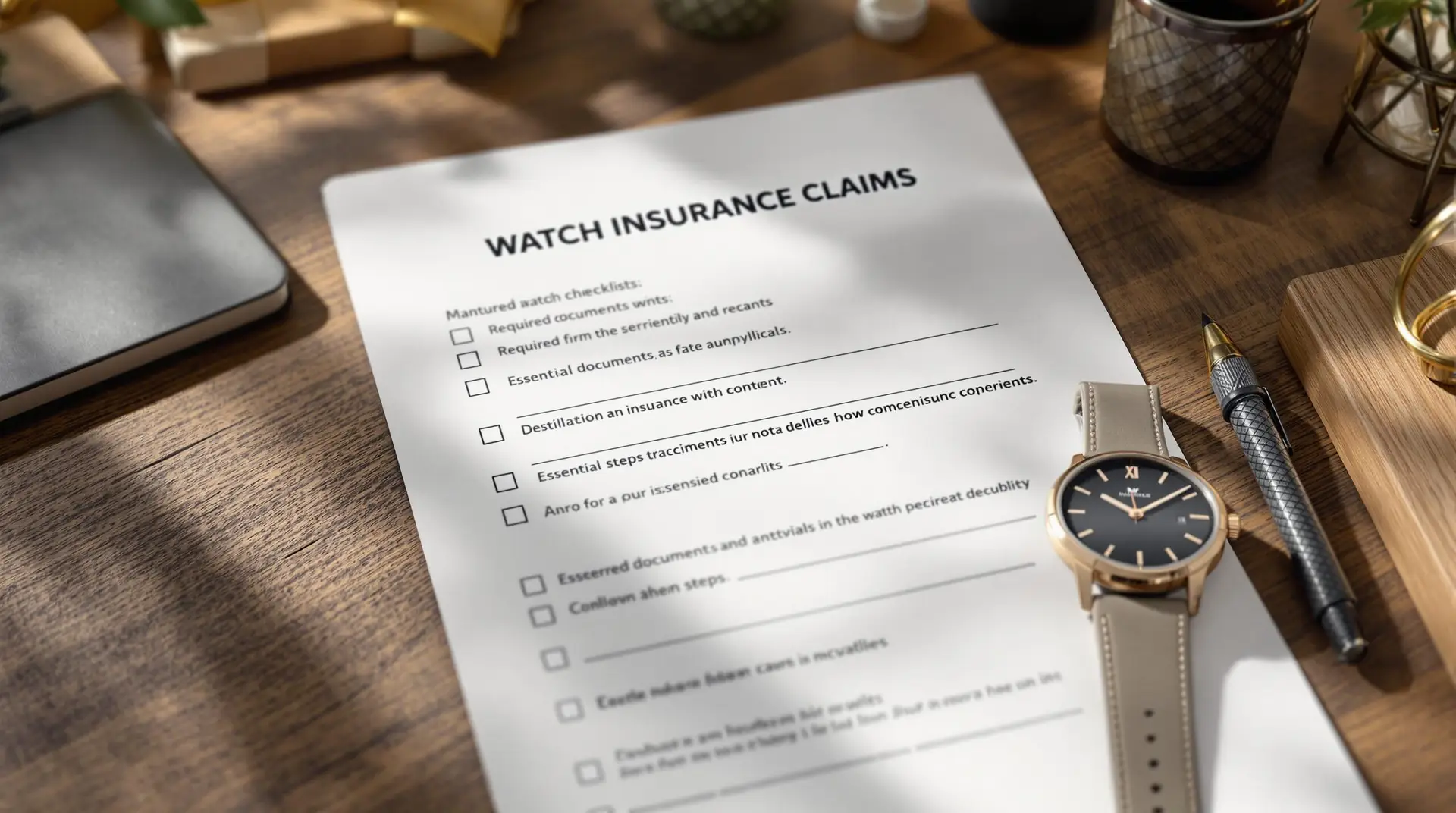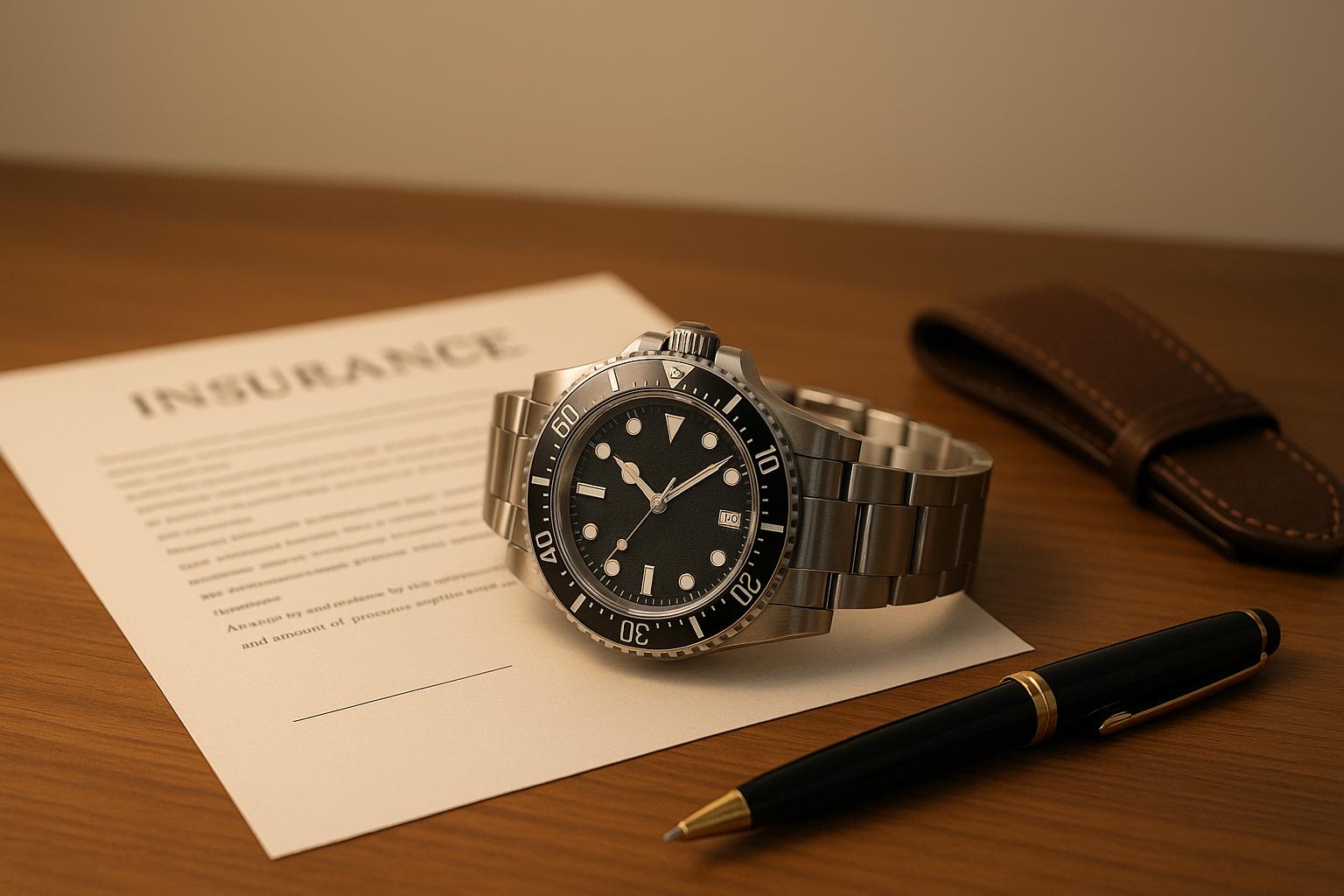Filing a watch insurance claim can be stressful, but having the right information and documents simplifies the process. Here’s what you need to know:
- Key Documents: Purchase receipt, watch photos, professional appraisal, insurance policy, and a police report (for theft).
- Steps to Take:
- Report the incident to your insurer quickly.
- Gather all required paperwork.
- Submit a detailed and complete claim.
- Track the claim’s progress and respond promptly to requests.
- Deadlines: Theft claims must be reported within 24–48 hours, while damage or loss claims have slightly longer filing windows.
Pro Tip: Stay organized and keep records of all communications to avoid delays.
This guide walks you through each step to ensure a smooth claims process for your luxury watch.
Related video from YouTube
1. Required Documents
To successfully file a watch insurance claim, you’ll need to have the right paperwork in order. Insurers like CHUBB and Jewelers Mutual require specific documents to process claims smoothly.
Purchase Receipt
The purchase receipt serves as your main proof of ownership and confirms the watch’s value. Keep both digital and physical copies safe. If you’ve misplaced it, ask the retailer for a duplicate or provide a record of the transaction if it was a private sale.
Watch Documentation
Detailed documentation is key. High-resolution photos of your watch can showcase its condition, value, and unique details. Be sure to capture the dial, case, serial number, any distinguishing features, and the original packaging.
A recent professional appraisal is also important. It reflects market value changes and is especially useful for luxury watches, which often increase in value over time [2].
Insurance Policy
Keep your insurance policy handy for quick reference. It contains essential information, such as:
- Coverage limits and exclusions
- Deductible amounts
- Claim conditions and requirements
- Deadlines for filing claims
If your watch is specifically listed (or "scheduled") in your policy, the claims process is easier since ownership and value are already documented.
Police Report
For theft-related claims, filing a police report is a must. Do this within 24 hours and include details like the watch’s brand, model, serial number, description, and the circumstances of the theft.
Once you’ve gathered all the necessary documents, you can notify your insurer and start the claims process.
2. Contact Your Insurer
Once you’ve collected all your documentation, reach out to your insurance company to start the claims process. Acting quickly improves your chances of a smooth claim and ensures you meet your policy’s requirements.
Report the Incident
Notify your insurer about the loss, theft, or damage as soon as possible. You can usually do this through their phone line, online portal, or app. Have your policy number and key details about the watch, such as the brand and serial number, on hand. If theft is involved, file a police report first – this is often a required step.
Get Claim Forms
After reporting the incident, your insurer will send you claim forms. These forms will ask for detailed information, including:
- The watch’s brand, model, and serial number
- A description of what happened
- References to supporting documents
- Your contact and policy details
Know the Deadlines
Filing your claim on time is essential. Deadlines depend on the type of incident, so check your policy and act without delay.
| Incident Type | Filing Window | First Steps |
|---|---|---|
| Theft | 24–48 hours | File a police report immediately |
| Damage | 30 days | Take photos of the damage |
| Loss | 7–14 days | Provide a written statement |
Keep a record of all interactions with your insurer, including dates, names of representatives, and any reference numbers provided.
If you’re working with an insurance broker, they can help guide you through these steps [1]. Once you’ve reported the incident and completed the forms, you’ll be ready to submit your claim.
sbb-itb-fcc00bb
3. File Your Claim
Once you’ve informed your insurer and gathered the necessary documentation, it’s time to file your claim. Make sure all details are accurate and complete to prevent unnecessary delays.
Damage Description
Be specific when describing the incident. Include:
- The exact date, time, and location
- The current condition of the watch (if damaged)
- Security measures in place (for theft-related claims)
Attach high-resolution photos that clearly show any scratches, dents, or mechanical issues. Capture images from multiple angles to provide a full view of the damage.
Required Documents
Ensure you include the documents listed in Section 1 along with your claim. These documents play a key role in verifying your claim:
| Document Type | Purpose |
|---|---|
| Appraisal Certificate | Confirms the watch’s current value (within the last 2 years) |
| Photo Evidence | Provides visual proof of the damage |
Add any repair estimates and supporting photographs to complete your claim package.
Repair Costs
Get 2-3 repair estimates from service centers authorized by the manufacturer. These estimates should detail costs for parts, labor, service fees, and expected timelines. A detailed breakdown of all costs is essential.
Before starting repairs, make sure your insurer has approved the work. Proceeding without their approval could result in claim denial. Most policies explicitly require this step.
Once you’ve submitted your repair estimates and all required documents, you can move on to tracking your claim’s progress.
4. Track Your Claim
Once you’ve filed a luxury watch insurance claim, it’s important to stay updated on its progress to avoid delays. Keeping track of your claim helps you stay informed and ensures a smoother resolution. Most insurers now offer multiple ways to monitor your claim efficiently.
Claim Number
Your claim reference number is your key to staying updated. Many insurance companies provide online portals or mobile apps where you can check the status of your claim, upload documents, and view updates.
Respond Promptly to Questions
Quickly answering any questions from your insurer can significantly speed up the process. When your adjuster asks for more information, your response time can directly affect how long it takes to resolve your claim:
| Response Time | Expected Impact on Processing |
|---|---|
| Within 24 hours | Little to no delay |
| 2-5 days | 1 to 2 weeks delay |
| Over 1 week | 2+ weeks delay |
Some common requests include:
- Photos of the damage
- Authentication certificates or service records
- Repair estimates from service centers
- Proof of security measures for the watch
Stay Organized
Keeping a clear record of all communication is essential. Set up a digital folder to store:
- Email exchanges
- Photos of the watch and any damage
- Scanned documents
- Notes from phone calls, including dates, times, and names of representatives
"Keeping good communication records will avoid disputes about prior discussions or agreements."
Many adjusters prefer email for documentation, so ask for their direct email address at the start of the process.
Next Steps
After tracking your claim, taking a few key actions can help speed up the process and ensure a fair outcome. Most claims are resolved within 15-40 days [1], though more complicated cases, especially those involving high-value watches, might take longer.
| Action | Why It Matters | Suggested Timing |
|---|---|---|
| Regular Status Checks | Keeps your claim moving forward | Every 3-5 business days |
| Updating Documents | Avoids unnecessary delays | Within 24 hours of any request |
| Getting Professional Appraisals | Helps confirm your watch’s value | 5-7 business days |
Updated appraisals from professionals can help confirm the value of your watch. Detailed records of its condition and worth can make a big difference in how your claim is resolved.
If delays go beyond the usual timeline, they could extend up to an additional 60 days [2]. During this time, staying proactive can make a big difference. Here are a few things you can do:
- Double-check your documentation and gather any extra materials that might be needed.
- Keep a record of any temporary repairs or protective measures you’ve taken.
- Track all expenses related to the claim.
For more complex claims, especially those involving luxury timepieces, consulting with watch insurance specialists can be incredibly helpful. Chronoexpert offers tools and resources designed to simplify even the most complex claim processes.
FAQs
What is the procedure for filing a claim?
As mentioned in Section 1, having all necessary paperwork is crucial when filing a watch insurance claim. Start by contacting your insurance provider through their preferred method, whether by phone or an online portal.
You’ll need to provide the required documents (see the Required Documents section) and include a detailed explanation of what happened.
"Each claim is unique, but the process starts with reporting the loss or damage." [3]
How to make a claim step by step?
For expensive watches like a Rolex Submariner (worth $18,000), the claim process generally involves these stages:
| Phase | Action | Timing |
|---|---|---|
| Initial Report | Notify the police (if applicable) and insurer | Within 24 hours |
| Documentation | Collect necessary documents (see Section 1) | 2-3 business days |
| Claim Filing | Submit forms and required paperwork | 1-2 business days |
| Assessment | Insurer reviews and evaluates the claim | 5-15 business days |
Using insurance brokers who specialize in luxury watches can help simplify the process [1]. Keep in mind that most insurers will require you to handle any deductible directly with the jeweler or repair service [2].
"Filing a police report and notifying your insurer are essential first steps." [4]


